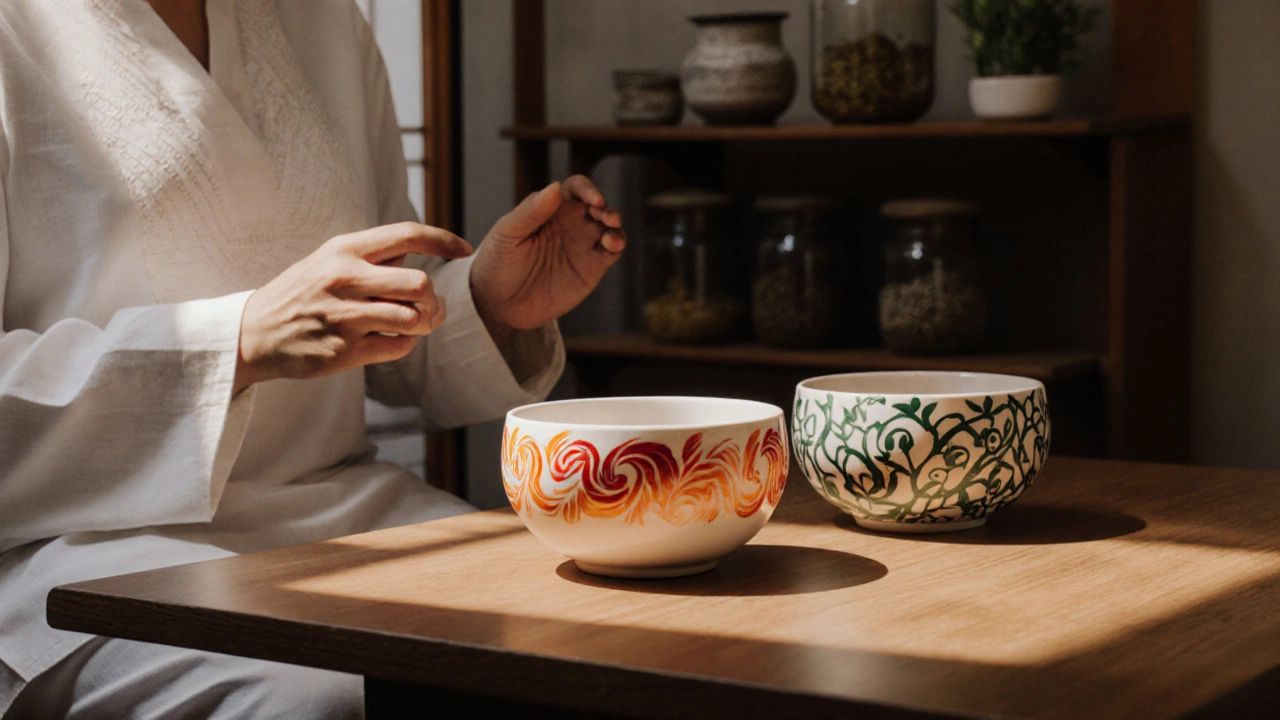
Ayurveda is often described as the 'science of life,' offering a holistic approach to health and wellness that dates back thousands of years. It is not just about curing the disease but maintaining a balance between the body, mind, and spirit. This traditional Indian practice emphasizes prevention and encourages the maintenance of health through close attention to balance in one's life, right thinking, diet, lifestyle, and the use of herbs.
Many people turn to Ayurveda for its natural methods of addressing common ailments. Through a personalized approach, it provides treatments that cater to individual needs rather than following a one-size-fits-all model. Each person is viewed as unique, with their constitution, or 'prakriti,' guiding the healing process.
The ailments Ayurveda can reputedly tackle range from digestive disorders and skin problems to stress and arthritis. So what exactly makes Ayurveda a viable option for those seeking alternatives to conventional medicine? Let's explore this ancient wisdom and discover how it can be integrated into modern lives.
- Understanding Ayurveda and Its Principles
- Common Diseases Ayurveda Can Address
- Herbs and Practices in Ayurvedic Treatment
- Tips for Integrating Ayurveda into Daily Life
Understanding Ayurveda and Its Principles
Ayurveda, an ancient system of natural healing, is deeply rooted in the traditions of India. It is one of the oldest comprehensive healthcare methods, dating back over 3,000 years. This time-honored practice is grounded in the belief that health and wellness depend on a delicate balance between the mind, body, and spirit. Unlike conventional medicine, which often focuses on treating symptoms, Ayurveda offers a holistic approach by addressing the root causes of ailments. It classifies the universe into five elements: ether, air, fire, water, and earth. These elements combine in the human body to form three life forces or energies, known as doshas: Vata, Pitta, and Kapha. Each person has a unique combination of these doshas that defines their physiological and psychological makeup, known as their prakriti.
Charaka, one of the principal contributors to Ayurveda, once stated, "Prevention is better than cure." His emphasis on prevention underscores the importance of maintaining balance through diet, lifestyle, and herbal therapies.
The concept of balance is central to Ayurveda. According to its principles, a disruption in the harmony of the doshas is believed to be the underlying cause of disease. Vata, associated with movement and space, governs activities like breathing and circulation. Pitta, linked to fire and water, regulates digestion and metabolism. Kapha, connected with earth and water, oversees strength and immunity. An individual's physical, mental, and emotional traits can be attributed to the predominant dosha, influencing their health and lifestyle choices. Ayurvedic practitioners meticulously assess a person’s dosha and develop personalized treatment plans to restore balance.
Ayurveda's natural healing mechanism hinges on several practices, including herbal medicine, Panchakarma detoxification therapies, and dietary modifications. Herbs play a fundamental role, offering therapeutic benefits without the side effects often seen with synthetic drugs. For instance, turmeric is esteemed not only for its culinary uses but also for its anti-inflammatory properties. Another principle is the Dinacharya, or 'daily routine,' which suggests that establishing a pattern in daily habits like waking, eating, and sleeping, helps to harmonize the doshas. Seasonal routines, known as Ritucharya, further guide lifestyle adjustments according to climatic changes, emphasizing the deep connection between humans and nature in Ayurvedic philosophy.
| Dosha | Elements | Attributes |
|---|---|---|
| Vata | Air, Ether | Movement, Fast |
| Pitta | Fire, Water | Heat, Intensity |
| Kapha | Earth, Water | Stable, Solid |
A distinctive aspect of Ayurveda is its tailored approaches to immunity and disease prevention. By understanding one's unique dosha constitution, individuals are encouraged to adopt practices that enhance their innate balance. Practitioners often advise integrating certain lifestyle habits, such as oil pulling with sesame oil for oral health or consuming ghee to aid digestion. Mindfulness and meditation are also integral, promoting mental clarity and peace. This connection between physical health and mental wellness echoes modern holistic practices, making Ayurveda both timeless and relevant. With an increasing global focus on personalized medicine, the principles of Ayurveda continue to garner attention for their ancient wisdom that resonates even in today's fast-paced world.
Common Diseases Ayurveda Can Address
Ayurveda is an ancient system of medicine that takes a unique and holistic approach to health. It believes in treating not just the symptoms but the root cause of diseases. By understanding an individual's 'prakriti,' or unique constitution, Ayurvedic practitioners can customize treatments to restore balance and health. One of the most remarkable aspects of Ayurveda is its ability to manage chronic conditions like arthritis. Arthritis, which causes inflammation and pain in the joints, is addressed in Ayurveda by reducing the vata dosha, which is believed to be responsible for such problems. Practices that focus on warm oil massages and special diets have shown to significantly reduce symptoms and improve quality of life.
Another area where Ayurveda shines is digestive disorders. With the widespread issue of digestive imbalances in today's fast-paced world, many turn to Ayurveda's prescribed diets, which focus on boosting digestive fire or 'agni.' Using herbs like ginger and cumin, and promoting mindful eating habits, Ayurveda helps alleviate conditions such as irritable bowel syndrome and acid reflux. This natural approach often succeeds where conventional treatments fall short, providing lasting relief. Interestingly, the legendary physician and scholar Charaka, states in the "Charaka Samhita," a core Ayurvedic text, that the root of all disease lies within digestion. Isn't that an eye-opener?
Skin diseases, too, find refuge under Ayurveda's care. Eczema and psoriasis are treated with herbal pastes and decoctions that cleanse blood impurities and calm aggravated doshas. Neem, turmeric, and sandalwood are formidable players in the Ayurvedic skin-care regimen promising improvement in both texture and tone. It's fascinating how Ayurveda taps into the natural healing powers of the earth. As stated in the popular ancient belief, glowing skin is a reflection of a well-balanced dosha system. Perhaps this deepened connection to the earth is what sets Ayurveda apart.
Citing the renowned Ayurvedic doctor, Dr. Vasant Lad, "Ayurveda is more about the promotion of vitality and health, ensuring that life is lived to the fullest."
The silent epidemic of stress-related disorders is extensively covered in Ayurvedic tradition. Ayurveda prescribes meditation, yoga, and breathing exercises, along with adaptogenic herbs like ashwagandha and brahmi to act as a salve for stress and anxiety. These practices help balance the body's energies, or 'doshas,' promoting both mental clarity and relaxation. Stress isn't just a modern problem; it's always been there. However, Ayurveda offers ancient wisdom to tackle it effectively, offering modern relief in a busy 21st-century context.
The holistic mind-body approach of Ayurveda, with its emphasis on diet, spices, lifestyle habits, and herbal remedies, is proving invaluable in managing diseases where allopathic remedies sometimes struggle. This doesn't negate the importance of modern medicine, but urges individuals to embrace a complementary path where ayurvedic treatment coexists with contemporary practices, aiming for a more comprehensive approach to health and healing.

Herbs and Practices in Ayurvedic Treatment
Ayurveda, with its deeply rooted principles, relies significantly on the power of nature, particularly through herbs, to treat and prevent various ailments. These herbs are not merely plants but powerful messengers of health. They hold a revered place in Ayurvedic texts, where each herb is assigned specific properties that help restore balance within the body's doshas – Vata, Pitta, and Kapha. This balance is essential for maintaining good health, an idea that echoes through the centuries in Ayurvedic traditions.
Let's start with one of the most celebrated herbs, Turmeric. Known as the 'golden spice,' it is adored not only for its culinary uses but for its myriad of health benefits. Turmeric contains curcumin, a compound renowned for its anti-inflammatory and antioxidant properties. Studies suggest that curcumin can help manage chronic conditions like heart disease and arthritis. Such natural contributions make turmeric indispensable in Ayurvedic healing.
Another significant herb is Ashwagandha, often referred to as the 'strength of a stallion' due to its stress-relieving qualities. It's considered an adaptogen, helping the body adapt to stress and restore balance. This herb has also been linked to increased energy levels and enhanced concentration. Evidence suggests that Ashwagandha might also improve sleep quality, acting as a natural aid for insomnia. These qualities are why Ashwagandha finds a central place in Ayurvedic prescriptions.
"Let your diet be your guide; let nature be your healer," says Dr. Vasant Lad, a prominent Ayurvedic physician, emphasizing the role of herbs in Ayurveda.
The role of herbs extends beyond mere ingestion in Ayurvedic practices. Many treatments involve topical applications, like using Neem for skin disorders. Neem is known for its potent antibacterial and antifungal properties and is frequently used in treatments for acne, eczema, and other skin conditions. Its bitter taste might not be pleasing to the palate, but its healing touch on the skin makes it a cherished part of Ayurvedic dermal solutions.
Apart from herbs, Ayurveda speaks volumes about specialized practices like Panchakarma, a detoxifying treatment meant to cleanse the body of toxins. This treatment encompasses five actions, including Vamana (therapeutic vomiting) and Basti (medicated enema), designed to purify the body from within. Such practices highlight Ayurveda's holistic approach, which underscores the belief that true health is the synergy between a clean body and a peaceful mind.
Daily Habits to Incorporate Ayurveda into Modern Life
Incorporating Ayurvedic wisdom into daily life doesn't necessitate sweeping lifestyle changes. Simple practices like oil pulling with sesame or coconut oil can improve oral health and detoxify the body. Drinking warm herbal teas, such as ginger or tulsi tea, can enhance digestion and bolster the immune system. Yoga and meditation remain integral to balancing energies and fostering mental clarity.
To nurture the modern Ayurvedic lifestyle, it’s crucial to follow a diet that aligns with one's dosha. This personalized approach ensures you consume foods that harmonize with your body's constitution, thus maintaining balance. Regularly engaging in self-care rituals, such as abhyanga (oil massage), plays a crucial role in Ayurveda. These rituals are often seen as forms of self-love, promoting physical and emotional well-being.
Ayurveda, with its treasure trove of natural healing techniques, remains relevant today as individuals seek paths toward holistic wellness. By embracing its herbal remedies and traditional practices, one can walk the journey towards health sustainability, blending ancient wisdom with modern need.
Tips for Integrating Ayurveda into Daily Life
Embracing Ayurveda in your daily routine can be like discovering a long-lost key that unlocks vibrant health and serenity. It's about melding the old with the new, harmonizing ancient wisdom with your modern life. Start small, perhaps with your morning routine. According to Ayurvedic principles, waking up before sunrise aligns you with natural rhythms and grants a peaceful start to your day. Begin by drinking warm water or herbal tea to kick-start digestion. This is not just a ritual but a way to awaken the system and prepare it for the nourishment to come. Sustained practices like this can lead to enhanced energy and clarity throughout the day.
Diet plays a crucial role in integrating Ayurveda into life. Mindfully consuming food is central to this approach. Each meal is an opportunity to balance the doshas—Vata, Pitta, and Kapha. These energies differ across individuals, meaning that one person's elixir might be another's poison. An effective strategy is to eat according to the season. During winter, steer towards warm, hearty soups or stews, complementing Vata to keep its erratic nature in check. Summer calls for lighter, cooling meals, aligning with Pitta's fiery essence. Spring, a Kapha-dominant time, benefits from light, astringent foods to ward off lethargy. This balanced eating approach not only nurtures your body but also connects you with nature's cycles.
Incorporating herbs and spices is another powerful way to integrate Ayurveda. The kitchen can be your apothecary, with common ingredients like turmeric, ginger, and cumin doing wonders beyond flavor. Turmeric, for instance, is renowned for its anti-inflammatory properties. A pinch in your evening milk—a traditional practice—can work wonders for a restful sleep. Ginger tea is an effective remedy for improving digestion, especially when consumed post-meal. Investing time to learn about these everyday spices can transform not just the taste of your meals but their medicinal value too. Ayurvedic treatment invites you to savor these gifts of nature, nurturing wellness from within.
A little known yet impactful aspect of Ayurveda is the practice of daily self-massage or Abhyanga. This practice, often using warm sesame or coconut oil, offers profound benefits. Regular self-massage can help reset the nervous system, alleviate stress, enhance circulation, and even improve sleep quality. By dedicating just ten minutes a day to this simple activity, you invest in a deeply fulfilling self-care ritual. As Ayurveda says, "When diet is wrong, medicine is of no use. When diet is correct, medicine is of no need." This ancient wisdom encapsulates the core message of Ayurveda: prevention and cure through mindful living.
Integrating natural healing into your life can extend to adopting specific breathing exercises, known as Pranayama, which are vital components of Ayurvedic healing. These exercises control your breath and, consequently, your mind. Techniques like Anulom Vilom and Kapalbhati are designed to balance the mind and body, enhance focus, and expel toxins. Engaging in even a few minutes of Pranayama daily can dramatically transform your mental space, preparing you to tackle the day with confidence. The integration of these practices reflects a commitment to not only physical well-being but mental wellness too.







